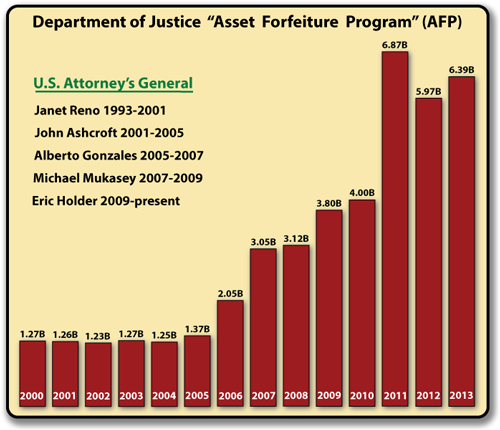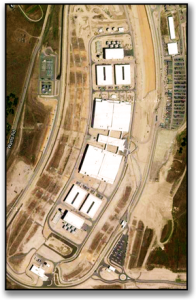 I’ve been reading a lot about citizen’s property and asset seizures by the Federal Government. It doesn’t seem right that they can do that, and I thought that a little research was in order here. Okay folks, this a long post so get some coffee and a doughnut.
I’ve been reading a lot about citizen’s property and asset seizures by the Federal Government. It doesn’t seem right that they can do that, and I thought that a little research was in order here. Okay folks, this a long post so get some coffee and a doughnut.
Much of this warrantless seizure stuff has materialized because of organized crime in the U.S. This is not a recent phenomenon either. It started with the “Tariff Act of 1930” because of organized crime activity then. Organized crime in the U.S. has grown exponentially since then. Recent legislation recognizes, and addresses the global ramifications of organized crime worldwide. Organized crime on the national scale has proliferated into international “Global Organized Crime and Terrorism”. The driving goal is the overwhelming desire to acquire money, and power. The criminals will stop at nothing to achieve their goals and the United States implemented methods to address and combat the vast power criminals have. One of the most damaging tactics applied to this end is “Asset Forfeiture”. First let’s review what types of federal forfeitures can legally take place.
Types Of Federal Forfeiture
Criminal forfeiture is an action brought as a part of the criminal prosecution of a defendant. It is an in person am (against the person) action and requires that the government indict (charge) the property used or derived from the crime along with the defendant. If the jury finds the property forfeitable, the court issues an order of forfeiture. For forfeitures pursuant to the Controlled Substances Act (CSA), Racketeer Influenced and Corrupt Organizations (RICO), as well as money laundering and obscenity statutes, there is an ancillary hearing for third parties to assert their interest in the property. Once the interests of third parties are addressed, the court issues a final forfeiture order.
Civil judicial forfeiture is an in rem (against the property) action brought in court against the property. The property is the defendant and no criminal charge against the owner is necessary.
Administrative forfeiture is an in rem action that permits the federal seizing agency to forfeit the property without judicial involvement. The authority for a seizing agency to start an administrative forfeiture action is found in the Tariff Act of 1930, 19 U.S.C. § 1607 (Selected statutes on the DOJ Portal). Property that can be administratively forfeited is: merchandise the importation of which is prohibited; a conveyance used to import, transport, or store a controlled substance; a monetary instrument; or other property that does not exceed $500,000 in value. Source: A Guide to Equitable Sharing of Federally Forfeited Property for State and Local Law Enforcement Agencies, U.S. Department of Justice, March 1994.
The Comprehensive Crime Control Act of 1984 established the Department of Justice Assets Forfeiture Fund to receive the proceeds of forfeiture and to pay the costs associated with such forfeitures, including the costs of managing and disposing of property, satisfying valid liens, mortgages, and other innocent owner claims, and costs associated with accomplishing the legal forfeiture of the property.
The Attorney General is authorized to use the Assets Forfeiture Fund to pay any necessary expenses associated with forfeiture operations such as property seizure, detention, management, forfeiture, and disposal. The Fund may also be used to finance certain general investigative expenses. These authorized uses are enumerated in 28 U.S.C. §524(c).**
Please see the Civil Asset Forfeiture Act of 2000 for a more detailed description of recent asset forfeiture legislation.
Although this seems like legitimate legislative recourse for our government in order to accomplish the goal of protecting American citizens, and compensating victims of crimes. The pesky thought that this is a huge amount of money that goes back into the operational budget of the program weighs heavy on my mind. The operational budget comes before the victims. In fact the Bureau of Prisons receives a portion as well, and their not on the list of entities that receive money from the fund?! So according to their fiscal report and financial statement for 2013 even whistleblowers get compensated before the victims do.
Let me get this right. The perpetrators and whistleblowers get compensated from the seized assets before the victims do. Sounds to me like the racketeer fighters have turned into the racketeers. They, in effect, have built a thriving business of seizing assets from others. But don’t believe me, read the reports and see for yourself in their Annual Financial Statements. Below are the official “Asset Forfeiture Program” and the “National Asset Forfeiture Strategic Plan” the DOJ is currently working under. Take note of the “Fiduciary Oversight” of the program. The fund no longer is required to compensate victims according to the oversight statement. Now it is purely a revenue generator for the twelve entities it collaborates with that benefit from the funds. A total of $40 billion dollars in assets have been seized since 2000. It’s no wonder our local police forces are likened to a standing army of law enforcement, or a “Police State” if you will. Here is a graph illustrating the general assets year-by-year from 2000-2013, and who the AG was at the time. The Assistant AG (Alice S. Fisher) stated that $700 million was returned to the victims of crimes involving forfeitures in 2007. That’s not what the financial statement reports. This program reeks of abuse by the DOJ, and the current administration, and their own reports counter what the Assistant AG states. She also states that “the program has forfeited over 2 billion in the past two years”. Try over 13 billion! These facts are there for anyone to look at. There is a saying that “Where there is smoke, there is fire.” It could also be said that where there are lies, there is abuse.” I’m feeling abused about this program.
From the Assistant Attorney General
“Taking the Profit out of Crime” is the theme of the National Asset Forfeiture Strategic Plan (2008–2012). Tremendous sums of monies are generated from illegal activity every year, and asset forfeiture has become a vital weapon in the United States’ anti-crime arsenal to strip criminals of their illicit wealth. The formulation of this national strategy is the first time that a comprehensive plan has been drafted to enhance and coordinate the use of this critical law enforcement tool. The Department of Justice is fully committed to using the asset forfeiture statutes to the fullest extent possible to investigate, identify, seize, and forfeit the assets of criminals and their organizations. Today, there is legal authority to forfeit the proceeds of virtually all serious offenses including terrorism, drug trafficking, organized crime, child pornography, alien smuggling, human trafficking, white collar crime, and money laundering. The National Asset Forfeiture Strategic Plan seeks to develop and implement policies and procedures to ensure that asset forfeiture is an integral part of every investigation and prosecution. he Asset Forfeiture Program has forfeited more than $2 billion during the past two years—and is in the process of returning nearly $700 million to victims of crime in FY 2007 alone. This is an important part of the Department’s Asset Forfeiture Program and one that cannot be underscored enough for victims of financial crime. This Strategic Plan seeks to highlight and expand the millions of dollars that are recovered and returned to victims of financial crimes every year through asset forfeiture. The Asset Forfeiture Program is a top priority for both the Criminal Division and the Department of Justice. The Program and the National Asset Forfeiture Strategic Plan have my strong personal support. Taking the profit out of crime is important to the American public, to our international community faced with the globalization of transnational crime, and to our national security.”
Alice S. Fisher
Assistant Attorney General
Criminal Division

Asset Forfeiture Program (AFP)
The Department of Justice Asset Forfeiture Program encompasses the seizure and forfeiture of assets that represent the proceeds of, or were used to facilitate federal crimes. The primary mission of the Program is to employ asset forfeiture powers in a manner that enhances public safety and security. This is accomplished by removing the proceeds of crime and other assets relied upon by criminals and their associates to perpetuate their criminal activity against our society. Asset forfeiture has the power to disrupt or dismantle criminal organizations that would continue to function if we only convicted and incarcerated specific individuals. The Asset Forfeiture Program (the Program) is a nationwide law enforcement initiative that removes the tools of crime from criminal organizations, deprives wrongdoers of the proceeds of their crimes, recovers property that may be used to compensate victims, and deters crime. As the Program has grown and matured, asset forfeiture has been used to attack the financial infrastructure of criminal enterprises, return funds to victims of large-scale fraud, and share forfeited property with state and local law enforcement agencies. Under the leadership of Chief Richard Weber, the Asset Forfeiture and Money Laundering Section (AFMLS) initiated a strategic planning process to carefully look at the Program Representatives from the asset forfeiture community worked together to develop this National Asset Forfeiture Strategic Plan (hereafter, the Plan). The Plan is the first-of-its-kind for the Program and is designed to:
- provide a strategic framework to enhance the capability, reach, and effectiveness of the Program;
- provide direction to the asset forfeiture community to ensure that the Program’s mission is carried out effectively and efficiently;
- enable Program participants to manage and expand this important and vital law enforcement tool;
- ensure maximum participation by all Program participants and determine appropriate areas of growth;
- and advocate for the resources needed to support and grow the Program.
National Asset Forfeiture Strategic Plan (The Plan)
Mission Statement: To use asset forfeiture consistently and strategically to disrupt and dismantle criminal enterprises, deprive wrongdoers of the fruits and instrumentalities of criminal activity, deter crime, and restore property to crime victims while protecting individual rights.
Vision Statement: To ensure that crime does not pay, the Department of Justice Asset Forfeiture Program will lead law enforcement to make the tracing and recovery of assets an integral part of every prosecution for the benefit of the American people.
The Program is comprised of the following 12 components:
United States Department of Justice:
• Criminal Division, Asset Forfeiture and Money Laundering Section
• Justice Management Division, Asset Forfeiture Management Staff
• Bureau of Alcohol, Tobacco, Firearms and Explosives
• Drug Enforcement Administration
• Executive Office for United States Attorneys
• Federal Bureau of Investigation
• United States Marshals Service
United States Department of Agriculture, Office of Inspector General
United States Department of Defense, Criminal Investigative Service
United States Department of State, Bureau of Diplomatic Security
United States Food and Drug Administration, Office of Criminal Investigations
United States Postal Inspection Service
The program participants represent agencies within and outside the Department of Justice. Each participant plays an important role in the Program. A brief description of each participant’s duties and responsibilities follows.
Asset Forfeiture Management Staff
The Asset Forfeiture Management Staff is responsible for the administrative management functions of the Asset Forfeiture Program. These functions consist of management of the Assets Forfeiture Fund (the Fund); management of both internal and external budget processes regarding the Fund; managing the investment of seized and forfeited funds; management and operation of the Consolidated Asset Tracking System (CATS); administration and oversight of asset forfeiture program-wide contracts; review, audit, and evaluation of asset forfeiture program activities; identification of program weaknesses and development, monitoring, and review of appropriate internal controls; and analysis of legislative, policy, and regulatory proposals that may affect the financial integrity of the Asset Forfeiture Program.
Assets Forfeiture Fund
The Comprehensive Crime Control Act of 1984 established the Fund to receive the proceeds of forfeiture and to pay the costs associated with such forfeitures. The Attorney General is authorized to use the Fund to pay any necessary expenses associated with forfeiture operations, such as property seizure, detention, management, forfeiture, and disposal.
Fiduciary Oversight
The Fund receives most of its revenue from the forfeiture of cash and other monetary assets and from the sale of forfeited property. The Fund’s first priority is to cover the operating expenses of the Asset Forfeiture Program. After it is determined that there will be sufficient receipts, allocations may be made for investigative expenses, such as awards for information, evidence, and equipping of conveyances, and discretionary expenses, such as storage, protection, and destruction of controlled substances.
Consolidated Asset Tracking System
CATS is a database that tracks assets seized by federal law enforcement agencies throughout the forfeiture life-cycle. Information about the seizure, custody, notification, forfeiture, claims, petitions, equitable sharing, official use, and disposal of assets is entered in CATS. For more information, visit http://www.justice.gov/jmd/foia/jmdcats.htm
Contracting Vehicles
The Asset Forfeiture Management Staff provides assistance with the establishment and application of contracting vehicles for use by agencies and offices within the Asset Forfeiture Program. The primary purposes of these contracts are to support law enforcement forfeiture-related investigative activities, provide ongoing, administrative support services involving document analysis and review, technical legal support, data entry and clerical support, and support to CATS through the acquisition of various types of support services.
For more information on the Asset Forfeiture Management Staff, visit http://www.justice.gov/jmd/afp/.
Bureau of Alcohol, Tobacco, Firearms and Explosives
The Bureau of Alcohol, Tobacco, Firearms and Explosives (ATF) moved from the U.S. Department of the Treasury to the U.S. Department of Justice in January 2003. ATF enforces the federal laws and regulations related to alcohol, tobacco, firearms, explosives, and arson by working directly and in cooperation with other federal, state, and local law enforcement agencies. ATF has the authority to seize and forfeit firearms, ammunition, explosives, alcohol, tobacco, currency, conveyances, and certain real property involved in the violation of federal law. For more information on the Bureau of Alcohol, Tobacco, Firearms, and Explosives, visit https://www.atf.gov/
Drug Enforcement Administration
The Drug Enforcement Administration (DEA) is responsible for implementing major investigative strategies against drug networks and cartels. DEA’s Asset Forfeiture Program is comprised of the following three sections:
Asset Forfeiture Section
The Asset Forfeiture Section is responsible for establishing, articulating, and implementing the policies related to the seizure and forfeiture of drug-related assets. The Asset Forfeiture Section’s primary responsibilities include processing and forfeiting seized assets; interpreting Department of Justice policies and guidelines; providing guidance on asset forfeiture issues to the field; providing asset forfeiture training; processing equitable sharing requests; processing award payments to informants; and administering monies from the Assets Forfeiture Fund to support the State and Local Overtime Program and the Marijuana Eradication Program.
Forfeiture Counsel Section
The Forfeiture Counsel Section is responsible for providing legal advice and assistance to field offices, coordinating pre-seizure planning and investigations, and preparing all legal documents related to the processing of DEA asset forfeiture cases. Attorneys in the Forfeiture Counsel Section also handle the execution of administrative declarations of forfeiture for property valued up to $100,000, international forfeiture issues, equitable sharing issues, petitions for remission, litigation support, Congressional inquiries, international and domestic asset forfeiture training. In addition, the Forfeiture Counsel Section represents the DEA in confidential informant litigation.
Office of Financial Operations
The mission of the Office of Financial Operations is to provide the expertise and investigative techniques needed to identify, document, and prosecute drug money laundering organizations. The Office of Financial Operations augments DEA’s domestic and foreign investigations by providing guidance, assistance, and coordination for the implementation of specialized money laundering groups in domestic field divisions; providing oversight, coordination and support of proactive money laundering operations; and providing specialized money laundering financial investigations training. The Office of Financial Operations also represents DEA’s interests regarding money laundering and financial investigations with federal, state, local, and international counterparts, and the financial services industries.
For more information on the Drug Enforcement Administration, visit http://www.justice.gov/dea/ops/af.shtml.
Executive Office for United States Attorneys
The U.S. Attorneys, under the direction of the Attorney General, serve as the nation’s principal litigators and are responsible for investigating and prosecuting those who violate our nation’s laws; for asserting and defending the interests of the United States, its departments, and agencies through the conduct of civil litigation; and for representing the United States in its appellate courts. There are 93 U.S. Attorneys located throughout the United States, Puerto Rico, the Virgin Islands, Guam, and the Northern Mariana Islands. Each U.S. Attorney serves as the chief federal law enforcement officer within his or her judicial district. The U.S. Attorneys’ Offices are responsible for the prosecution of both criminal and civil actions against property used or acquired during illegal activity. Since the enactment of asset forfeiture legislation, the U.S. Attorneys’ Offices have used both criminal and civil asset forfeiture laws to strip away property derived from criminal activity, such as narcotics violations, money laundering, racketeering and fraud, as well as property used to facilitate the commission of certain crimes. For more information on the United States Attorneys’ Offices, visit www.usdoj.gov/usao.
Federal Bureau of Investigation
The Federal Bureau of Investigation (FBI) is responsible for investigating a broad range of criminal violations including white collar crime, organized crime, and terrorism. FBI’s Asset Forfeiture Program is comprised of the following three units:
Economic Crimes Unit II
The mission of the Economic Crimes Unit II is to promote the strategic use of asset forfeiture and to ensure that field offices employ the money laundering violation in all appropriate investigations. The Unit oversees all bankruptcy fraud matters, as well as the Financial Institution Fraud Program which investigates mortgage fraud, check fraud, credit card fraud, and e-banking.
Forfeiture and Seized Property Unit
The mission of the Forfeiture and Seized Property Unit is to provide administrative support in the areas of budgeting, processing seized assets for forfeiture, reporting on administrative matters, and providing oversight to paralegals and contract personnel in the field.
Legal Forfeiture Unit
The mission of the Legal Forfeiture Unit is to provide legal forfeiture guidance and training to FBI Headquarter Divisions, the Department of Justice, and FBI field offices, so that those entities can successfully utilize the forfeiture sanction to remove the profit from crime, dismantle existing and emerging organized criminal enterprises and terrorist organizations, and disrupt those activities which threaten the physical or economic security of the United States and its allies.
For more information on the Federal Bureau of Investigation, visit http://www.fbi.gov/about-us/investigate/white_collar/asset-forfeiture.
United States Marshals Service
In 1984, the United States Marshals Service was given responsibility for the custody, management, and disposition of all assets seized for forfeiture by federal law enforcement agencies participating in the
“Department of Justice Asset Forfeiture Program”. The Marshals Service aids the investigative agencies and their respective U.S. Attorneys’ Offices in making informed decisions about what will be seized. With a cadre of experts available to provide analytical tools and services to assist in the valuation of targeted assets, the Marshals Service ensures that the property targeted for forfeiture has significant equity to cover the costs of storing and maintaining the asset during the litigation period. The Marshals Service disposes of forfeited assets in the form of sales (e.g., Internet, auction, and consignment), destruction, donations, and other methods including returns and retention for official use. The methods used to dispose of forfeited assets are tailored to the specified type and intrinsic value of the property being sold. Auction sales are normally used for volume sales, such as vehicles. Direct sales, brokered sales, and the acceptance of unsolicited offers are also utilized. The Marshals Service also executes approved equitable sharing to state and local law enforcement agencies that participated in the underlying investigation. Since the inception of the Assets Forfeiture Fund, over $4 billion has been shared with state and local law enforcement agencies and foreign governments. For more information on the Marshals Service, visit www.usdoj.gov/marshals/assets.
United States Department of Agriculture, Office of Inspector General
The Office of Inspector General works closely with U.S. Attorneys’ Offices as well as federal, state, and local law enforcement agencies to investigate fraud and criminal activity that affect programs run by the U.S. Department of Agriculture. These programs encompass a broad spectrum of areas including consumer protection, nutrition, animal and plant health, agricultural production, agricultural product inspection and marketing, rural development, research, conservation, and forestry. The Office of Inspector General uses asset forfeiture to conduct investigations and prevent fraud, waste, and abuse in the programs and operations of the U.S. Department of Agriculture. Criminal investigators and auditors in the Office of Inspector General have specialized knowledge about complex agriculture programs, requirements, and vulnerabilities. This expertise is critical for resolving criminal allegations, preventing and deterring future instances of illegal or fraudulent acts of misconduct, and promoting the effectiveness and integrity of the hundreds of programs administered by the U.S. Department of Agriculture. For more information on the Office of Inspector General, visit www.usda.gov/oig.
United States Department of State Bureau of Diplomatic Security
The Bureau of Diplomatic Security is a unique organization that plays an essential role within the U.S. Department of State. The Bureau’s personnel—who include special agents, engineers, diplomatic couriers, civil service specialists, and contractors—work together as a team to ensure that the State
Department can carry out its foreign policy missions safely and securely. Diplomatic Security has a broad scope of global responsibilities, with protection of people, information, and property as its top priority. Diplomatic Security conducts criminal investigations into violations of passport and visa fraud. These federal felonies are often committed in connection with more serious crimes, such as international terrorism, narcotics trafficking, organized crime, alien smuggling, money laundering, pedophilia, and murder. Diplomatic Security provides support, policy guidance, and oversight of all investigative activity related to passport and visa fraud, as well as coordinating investigative assistance with federal, state, and local law enforcement agencies. Diplomatic Security became a member of the Fund in October 2004. Despite its recent acceptance into the Fund, Diplomatic Security’s Asset Forfeiture Program has experienced significant growth. The Asset Forfeiture Program is responsible for continually developing, modifying, and providing an aggressive forfeiture-related training program to Diplomatic Security employees and directly supporting major field office and foreign embassy visa, passport, and/or document-related forfeiture investigations. For more information on the Bureau of Diplomatic Security, visit www.state.gov/m/ds.
United States Food and Drug Administration, Office of Criminal Investigations
The United States Food and Drug Administration is the nation’s oldest consumer protection agency. The agency regulates over $1 trillion of consumer products and is responsible for protecting the public health by ensuring the safety, efficacy, and security of human and veterinary drugs, biological products, medical devices, our nation’s food supply, cosmetics, and products that emit radiation. The agency is also responsible for advancing the public health by helping to increase innovations that make medicines and foods effective, safe, and affordable. The Office of Criminal Investigations was created in 1992 to investigate major violations of the Federal Food, Drug, and Cosmetic Act, the Federal Anti-Tampering Act, and other related laws designed to protect the nation’s highly regulated system for approving and distributing prescription drugs, medical devices, and foods. The Office of Criminal Investigations is responsible for enforcing federal criminal laws involving the sale, distribution, or importation of adulterated and misbranded drugs, unapproved drugs, and the sale or the illegal dispensing of prescription drugs. Many cases are the result of joint enforcement efforts among federal and state agencies, and asset forfeiture is used in all investigations where it is available under the law.
For more information on the Office of Criminal Investigations, visit www.fda.gov.
United States Postal Inspection Service
The United States Postal Inspection Service is one of our country’s oldest federal law enforcement agencies. Founded by Benjamin Franklin, the Postal Inspection Service has a long, proud, and successful history of fighting criminals who attack and misuse our nation’s postal system to defraud, endanger, or otherwise threaten the American public. Postal Inspectors are federal law enforcement officers who carry firearms, make arrests, execute federal search warrants, and serve subpoenas. Inspectors work closely with U.S. Attorneys, other law enforcement agencies, and local prosecutors to investigate postal cases and prepare them for court. Postal Inspectors enforce roughly 200 federal laws covering investigations of crimes that adversely affect the postal system including mail fraud, money laundering, and drug trafficking. For more information on the Postal Inspection Service, visit www.postalinspectors.uspis.gov.
United States Department of Defense, Criminal Investigative Service
The Defense Criminal Investigative Service (DCIS) is the criminal investigative arm of the Department of Defense (DoD) Office of Inspector General. DCIS is responsible for protecting America’s warfighters by conducting investigations in support of crucial national defense priorities. These investigations include terrorism, protection of Defense technology, substandard or defective products destined for the use of our warfighters, cybercrimes and computer intrusions, major thefts, and major procurement fraud including bribery, public corruption, money laundering, and kickbacks. Our vision is to remain a versatile, responsive, and respected premier federal law enforcement agency demonstrating excellence in all aspects of our operations. DCIS has statutory law enforcement authority based on Title 10 United States Code 1585 (a); consequently, every agent is designated by law as a federal law enforcement officer. DCIS has 6 field offices and 40 subordinate offices that employ approximately 325 agents in the United States and overseas, including Kuwait and Iraq. Additionally, in July 2007, the DoD Office of the Inspector General opened a field office in Afghanistan. For more information on the Defense Criminal Investigative Service, visit http://www.dodig.mil/INV_DCIS/index.cfm.
The Treasury Forfeiture Program
The Treasury Forfeiture Fund (TFF) was established in 1992 as the successor to what was then the Customs Forfeiture Fund (See 31 U.S.C. § 9703). The TFF is administered by the Treasury Executive Office for Asset Forfeiture (TEOAF) and is the receipt account for the deposit of non-tax forfeitures made by the following member agencies:
- United States Department of the Treasury
- Internal Revenue Service, Criminal Investigation
- United States Department of Homeland Security
- U.S. Immigration and Customs Enforcement
- U.S. Customs and Border Protection
- U.S. Secret Service
- U.S. Coast Guard
The creation of the TFF brought together all then-Treasury law enforcement agencies. Although some bureaus were subsequently transferred to the Department of Homeland Security by the Homeland Security Act of 2002, they remain participants of the TFF. For more information on The Treasury Forfeiture Program, visit http://www.treasury.gov/resource-center/terrorist-illicit-finance/Pages/Asset-Forfeiture.aspx.
**
This asset seizure program should:
- Have an injunction placed on it until an equitable method of compensating the victims of the crimes committed can be instituted.
- Have no more than 25% of the fund used for operating expenses.
- Allow local, regional, state, and federal law enforcement entities to receive no more than 10% of the total revenue of the fund.
- Use the remaining 65% of the fund to compensate victims of the crimes leading to asset seizures.
After reviewing the “DOJ’s” financial statements it is my opinion that the fund and the plan are being used as a method to make law enforcement bigger. It promotes the twelve entities involved in sharing large amounts of money from the fund. This allows them to reconcile to themselves the sidestepping of the law and questionable seizures of property and assets from innocent citizens. Doing so enhances the amount each entity receives from the fund. Because of the vast amounts of money involved in this program, and the tangible interests of our American Citizens at stake, the GAO”, and a Congressional Oversight Committee should manage the “Asset Forfeiture Program” closely. I will also say that from 2008 to the present the AFP’s assets have increased nearly five-fold. I don’t know if this is because the economy is poor and organized crime is festering more, or if the current administration and AG have something more to do with it. The current president did say he wanted our law enforcement to be at least as large as our military. Maybe he has found a way to do it without the general populous realizing it. Just a thought.
** Sourced from U.S. Attorney General Website and is available under the FOIA.
 Since immediately after the United States Civil War the healthcare for military veterans was established. It started by administering to the medical needs of all military veterans in “veterans homes” throughout the country. It carried through until after WWI. In 1930 the Veterans Administration was founded to consolidate and care for the medical, pension, and various rehabilitation project benefits that our veterans were guaranteed by congress. Near the end of WWII the veteran population from WWII was 14,000,000 and the aging WWI veteran population was 4,000,000. This is when the first bottlenecks in medical care for our veterans were noticed. In response President Roosevelt, and later President Truman decentralized the VA hospitals and care facilities from 54 hospitals to 171 and over 700 outpatient facilities throughout the country.
Since immediately after the United States Civil War the healthcare for military veterans was established. It started by administering to the medical needs of all military veterans in “veterans homes” throughout the country. It carried through until after WWI. In 1930 the Veterans Administration was founded to consolidate and care for the medical, pension, and various rehabilitation project benefits that our veterans were guaranteed by congress. Near the end of WWII the veteran population from WWII was 14,000,000 and the aging WWI veteran population was 4,000,000. This is when the first bottlenecks in medical care for our veterans were noticed. In response President Roosevelt, and later President Truman decentralized the VA hospitals and care facilities from 54 hospitals to 171 and over 700 outpatient facilities throughout the country.





